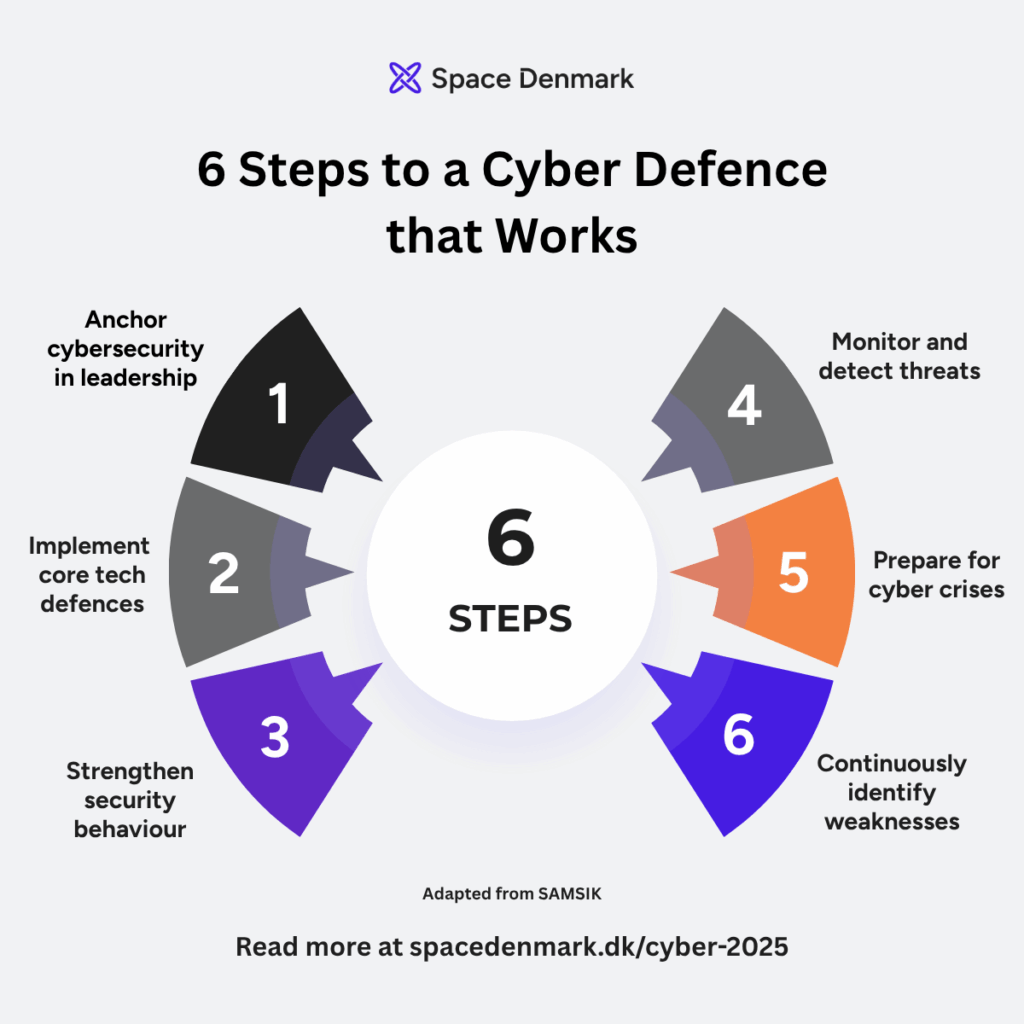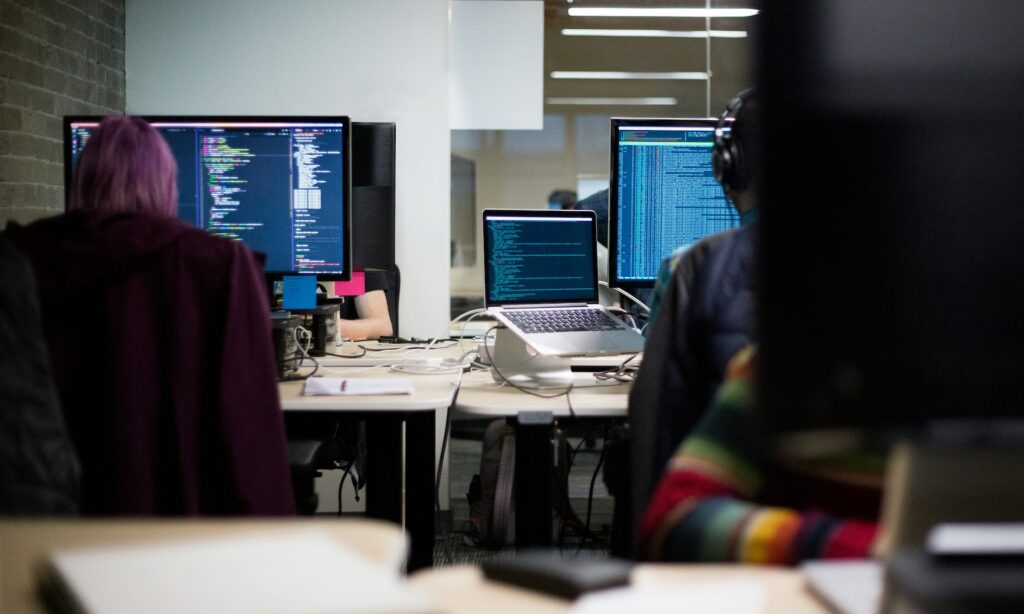As Denmark’s space ambitions grow, so does the interest of cyber adversaries. A recent Space Denmark webinar shed light on how the sector can defend itself.
On 9 October, Space Denmark hosted a webinar in collaboration with the Danish Resilience Agency (SAMSIK) focused on strengthening the cyber resilience of actors in the Danish space sector. The session invited Danish space professionals to learn about the latest cyber threat assessment for the space domain and practical steps organisations can take to improve their resilience.
What the Threat Assessment Reveals
The webinar was hosted by Søren Gram Riisgaard, Founder and CEO of Space Denmark, and two experts from SAMSIK, Simon Munk, Cyber Analyst, and Mikkel Christensen, Cyber Advisor, explain the new cyber threat assessment and concrete recommendations for Danish space companies and institutions.
“The threat from cyber espionage against the space sector in Denmark is VERY HIGH. It is highly likely that organisations in the Danish space sector will be subjected to attempts at cyber espionage within the next two years.”
Danish Resilience Agency (SAMSIK), Cyber Threat Assessment for the Danish Space Sector 2025
The webinar was grounded in SAMSIK’s newly published cyber threat assessment for the Danish space sector (read it here), which outlines a complex and serious threat landscape:
-
- Cyber Espionage poses a very high threat. Foreign states maintain a persistent interest in Danish space technologies, particularly because they serve both civilian and military purposes. This dual-use nature makes the sector attractive for strategic intelligence gathering.
-
- Cyber Crime also represents a very high threat. Criminal hackers regularly target organisations across Denmark, and the space sector is no exception. Ransomware attacks, data theft, and the resale of system access are among the most significant risks.
-
- Cyber Activism is assessed as a moderate threat. While activists do target Danish organisations, the space sector is currently seen as less symbolically significant compared to other domains, which lowers its profile among these groups.
-
- Destructive Cyber Attacks are also considered a mo
derate threat, primarily originating from Russia. Like other critical sectors, space infrastructure could be targeted in broader campaigns aimed at disruption or sabotage.
- Destructive Cyber Attacks are also considered a mo

Why the Space Sector is a Cyber Target
The space sector faces unique and heightened cyber risks due to its strategic and technological profile. It is a domain characterised by high levels of innovation, where cutting-edge technologies are often dual-use, serving both civilian and defence purposes. NATO has formally recognised space as an operational domain, placing it alongside air, land, maritime, and cyberspace in terms of strategic importance. The sector is also closely tied to national prestige and sovereignty, making it a symbolic and tactical target for foreign states that are themselves active in space.
Space infrastructure underpins other critical sectors, such as communications, navigation, and climate monitoring, creating a single point of failure that could have cascading effects across society. The sector’s reliance on international cooperation and shared assets further increases its exposure, as vulnerabilities in one part of the ecosystem can affect others. These factors make the space sector a high-value target for both state-sponsored cyber operations and criminal actors.
How Can Space Companies Protect Themselves?
In addition to presenting the current threat landscape, the webinar focused on how organisations in the space sector can strengthen their cyber defence. The discussion was based on the six-step framework outlined in SAMSIK’s guide Cyberforsvar der virker. This framework offers a structured approach to improving cybersecurity through leadership involvement, technical measures, behavioural initiatives, monitoring, crisis preparedness, and continuous evaluation.
Six Steps to Stronger Cyber Defence
1. Anchor cybersecurity in leadership
Treat cyber defence as a strategic responsibility. Senior leaders must set direction, ask the right questions, and ensure the organisation has the right skills.
2. Implement core technical defences
Put essential protections in place, such as updates, access controls, and backups. These are the building blocks of a secure IT environment.
3. Strengthen security behaviour
People shape security outcomes. Build awareness and encourage safe habits to reduce human risk.
4. Monitor and detect threats
Keep watch over systems and data. Early detection helps limit damage and respond quickly to attacks.
5. Prepare for cyber crises
Have a clear plan for handling incidents. Define roles, streamline communication, and rehearse your response.
6. Continuously identify weaknesses
Security is an ongoing process. Regular assessments and lessons from past incidents help you stay ahead.
Further Reading and Resources
The cyber threat landscape facing the Danish space sector is complex and evolving. Addressing it requires a shared understanding of the risks and a commitment to strengthening resilience across organisations. The recent webinar highlighted both the urgency and the practical steps available to move forward.
For those interested in exploring the topic further:
Download the full guide (in Danish): Cyberforsvar der virker
Read the threat assessment (in Danish): Cybertruslen mod rumsektoren
Learn more about SAMSIK’s work and contact them directly: samsik.dk/kontakt
Join the Network
Space Denmark is working to strengthen collaboration and resilience across the Danish space sector. By becoming a member, you gain access to future events, expert insights, and a growing community committed to advancing Denmark’s role in space. Whether your organisation is focused on research, technology, operations, or policy, membership offers a platform for shared learning and coordinated action.
Become a member of Space Denmark to take part in our mission for a stronger Danish space sector:

